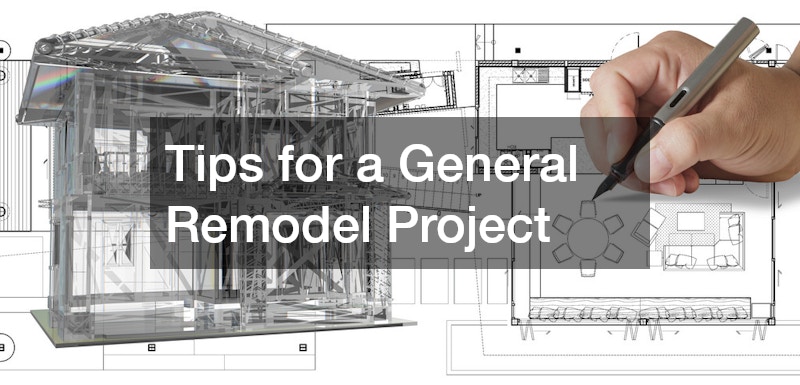Embarking on a remodeling project is both exciting and challenging. Whether you’re updating a single room or undertaking a full-home transformation, knowing the right steps to take can ensure a smooth and successful remodel. From setting clear goals to managing a budget effectively, this article will guide you through the most important aspects of a general remodel, helping you make informed decisions every step of the way.
How Do I Plan for a General Remodel?

A successful remodel starts with solid planning. Without a clear roadmap, it can be easy to get off track. Here’s how to set yourself up for success:
Setting Clear Goals
Before diving into the remodel, it’s important to define what you want to achieve. Are you remodeling to increase your home’s value for a future sale, or are you creating a space that better fits your lifestyle and current needs? Whether you’re looking to enhance functionality, modernize outdated areas, or improve energy efficiency, having clear and specific goals will help guide your decisions on design, materials, and budget. This clarity will ensure you stay focused and make choices that align with your vision for the space, whether you’re installing new residential garage doors, upgrading your septic system, or incorporating sustainable features like synthetic grass or heat pumps. Understanding your end goals will make the entire remodeling process more intentional and fulfilling. Additionally, having a well-defined objective will help you evaluate potential changes, prioritize projects, and ensure that each decision contributes to your ultimate vision.
Establishing a Budget
Establishing a realistic budget is crucial for any remodel. Consider the costs of materials, labor, permits, and any unforeseen expenses. It’s wise to set aside 10-20% of your budget for contingencies, as unexpected issues often arise during remodeling projects. You may need to rent a roll off dumpster rental to help with debris removal, or consult an insulation company for advice on upgrading your home’s insulation.
Creating a Timeline
Set a realistic timeline for your remodel, factoring in how long each phase will take. Construction often takes longer than expected, so build in some extra time for potential delays. Establishing a timeline will help you manage expectations and keep the project on track, especially when working with a
local building contractor
who may have other projects lined up.
Hiring a Design Professional
If you’re unsure where to start or lack the expertise to envision your remodel, hiring a design professional can be a great investment. A design professional, such as an interior designer or architect, can help you create a cohesive and functional layout that aligns with your goals and lifestyle. They can assist with everything from color schemes and materials to furniture placement and lighting design.
One of the main benefits of hiring a designer is that they can help you avoid costly mistakes. They can also help you make the most of your space by maximizing functionality while keeping aesthetics in mind. Whether you’re remodeling a kitchen, bathroom, or an entire home, a designer can offer expert advice that will enhance both the style and usability of your space.
A design professional can also assist in selecting the right materials and finishes that align with your budget, providing options that are both cost-effective and high-quality. If your remodel involves more specific technical elements, such as integrating heat pumps, adding synthetic grass to your landscaping, or installing residential garage doors, a designer can help you navigate the best choices for both appearance and performance.
Additionally, when remodeling, there are often structural or technical considerations to take into account. A design professional will have experience in working with other contractors and professionals to ensure everything is properly coordinated. They can help you choose the best solutions for things like septic systems or ensuring that your remodel complies with local building permits and regulations. By working with a designer, you can avoid costly rework and ensure your remodel is both functional and up to code.
Moreover, hiring a designer can help streamline your remodel process. A well-organized designer will be able to create a comprehensive plan and timeline, helping you stay on track. They can act as a liaison between you and the contractors, managing the details and ensuring that the work is done according to plan. This can be especially helpful when working with a local building contractor to ensure all aspects of the project run smoothly.
Lastly, if you are looking to create a space that is both beautiful and environmentally conscious, a design professional can offer sustainable options. For instance, they can recommend eco-friendly materials, energy-efficient appliances, or systems like heat pumps that will help reduce your home’s carbon footprint and lower utility bills over time.
By hiring a design professional, you’re not just ensuring that the remodel meets your aesthetic desires, but also that it will add lasting value to your home.
Acquiring Permits and Approvals
Depending on your location and the scope of your remodel, you may need various building permits or approvals from your local government. Permits are often required for structural changes, electrical or plumbing work, or any significant alterations to the home, such as installing new residential garage doors, upgrading septic systems, or modifying the landscape with synthetic grass. The types of permits you need will vary depending on local regulations and the specific work you are doing.
It’s essential to consult with professionals, such as a local building contractor or permitting specialist, to understand what is required in your area. They can help guide you through the permit application process and ensure your remodel complies with all local codes and regulations. Failure to acquire the necessary permits can result in fines, delays, or the need to undo completed work.
In some cases, your remodel may also require inspections to verify that the work meets safety standards. For example, when installing new heat pumps or making electrical changes, an inspection may be necessary to ensure everything is up to code. It’s important to factor in these potential delays when setting your timeline.
By acquiring the proper permits and approvals in advance, you can avoid complications and ensure that your remodel is both legally compliant and safe for long-term use.
How to Choose the Right Contractor?

The right contractor is essential to the success of your remodel. Here’s how to find the best fit for your project:
Research and Recommendations
Start by researching contractors in your area and seeking recommendations from friends, family, or online reviews. A reputable local building contractor should have positive feedback and a proven track record.
Checking Credentials and Licenses
Always check that your contractor is licensed and insured. This ensures they have the necessary skills and protection in case something goes wrong during the project. Additionally, ensure they have experience working with septic systems or installing heat pumps, depending on the scope of your remodel.
Reviewing Past Work
Ask contractors for examples of their past work. This will give you an idea of their craftsmanship and whether their style aligns with your vision for the remodel, whether you’re adding a water feature to the yard or installing residential garage doors.
Understanding Contract Terms
Once you’ve chosen a contractor, make sure you understand the terms of your agreement. The contract should outline payment schedules, project timelines, and the scope of work. Clear communication now can prevent misunderstandings later.
Communication and Compatibility
Effective communication is key. Ensure that you feel comfortable working with your contractor and that they understand your goals. A good contractor will listen to your ideas and offer practical solutions.
How Can I Manage My Remodel Budget Effectively?

Managing your budget during a remodel can be tricky, but it’s vital to avoid overspending. Here are some ways to stay on track:
Identifying Essential Expenses
Prioritize the most essential elements of your remodel. Consider what you need versus what you want, and allocate funds accordingly. For example, focusing on concrete flooring might be more urgent than installing new a vanity.
Allocating Funds for Contingencies
Set aside a portion of your budget for unexpected costs. No matter how well you plan, unforeseen issues like structural problems or material price increases are common. You might find that you need to adjust your budget if you encounter septic system issues or the need for additional propane service.
Tracking Expenses Regularly
Keep track of your spending throughout the project using apps or spreadsheets. Regular tracking helps you identify potential overspending early. This can help you avoid spending too much on features you don’t need.
Making Cost-effective Choices
There are many ways to save money without sacrificing quality. Opt for cost-effective materials, shop around for deals, or consider tackling some tasks yourself if you’re able. For example, some people choose to install heat pumps or upgrade insulation without professional help if they have the necessary skills.
Dealing with Unexpected Costs
When unexpected costs arise, assess whether they are necessary or if you can make adjustments elsewhere in your budget. Staying flexible will help you navigate these challenges. For instance, if you run into issues with concrete work, you may need to revise other aspects of your remodel to stay within budget.
What Design Considerations Should I Keep in Mind?

The design of your remodel should reflect both your personal style and practical needs. Here are some key considerations:
Defining Your Style
Your home should reflect your personal tastes. Whether you prefer modern, rustic, or traditional styles, defining your aesthetic will guide your choices in materials, colors, and finishes, such as choosing between various roofing options or selecting materials for your patio.
Balancing Trends with Timeless Elements
While it’s tempting to follow the latest trends, remember to balance them with timeless design elements that will stand the test of time. Consider neutral palettes and classic fixtures that will remain appealing long after trends fade.
Prioritizing Functionality
Functionality should always come first. Ensure your design choices meet your daily needs, such as adequate storage, workspace, or traffic flow. If you’re remodeling a basement or garage, consider installing doors that complement the space’s function.
Considering Resale Value
Even if you’re not planning to sell your home right away, consider how your remodel will impact its resale value. Features like updated kitchens, heat pumps, or propane service can add significant value.
Selecting Sustainable Materials
Sustainability is becoming increasingly important in home renovations. Opting for eco-friendly materials can benefit both the environment and your long-term energy savings. This could include choosing more energy-efficient insulation or using concrete sourced from sustainable suppliers.
How to Effectively Manage the Remodel Timeline?
Timely project completion is key to a successful remodel. Here’s how to manage your timeline:
Creating a Realistic Schedule
Work with your contractor to create a schedule that outlines each stage of the project. Factor in time for potential delays and keep track of progress regularly.
Allowing for Flexibility
Unexpected delays are common, so be prepared for them. Allowing flexibility in your timeline will help you avoid stress if things don’t go exactly as planned. If your project involves septic system installation or concrete work, extra time might be needed for permits and inspections.
A general remodel can be a rewarding experience, but it requires thoughtful planning and execution. By managing your budget effectively, selecting the right contractor, and considering important design factors, you can ensure your remodel goes smoothly. Whether you’re replacing residential garage doors, installing a heat pump, or upgrading your septic system, keeping these tips in mind will help you create a space that reflects your personal style while enhancing your home’s functionality and value. Additionally, prioritizing sustainability, planning for contingencies, and staying organized throughout the process will further ensure that your remodel meets both your immediate needs and long-term goals.
As you move forward with your project, remember that communication with your contractor and design team is key to preventing issues and ensuring that your vision is realized. Flexibility is also important, as unexpected challenges can arise, but with the right preparation, you’ll be able to adapt and make informed decisions. Investing time and effort in understanding each aspect of the remodel—from acquiring necessary building permits to considering energy-efficient upgrades like synthetic grass—will result in a remodel that not only elevates your living space but also adds value to your home. In the end, a well-executed remodel can transform your home into a place that suits your lifestyle and stands the test of time.



